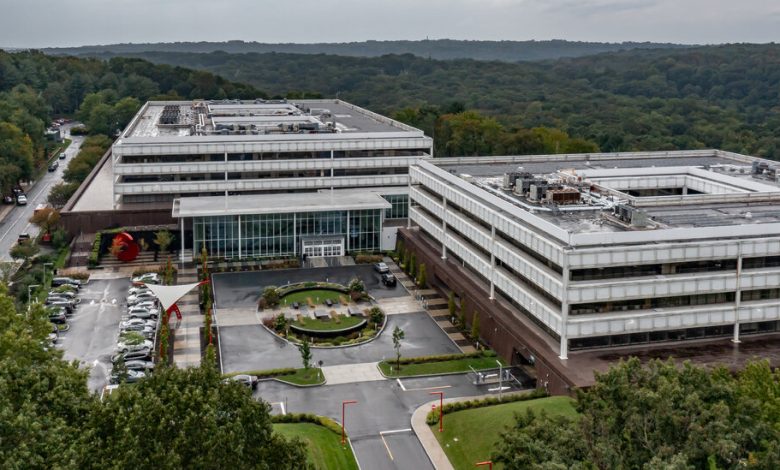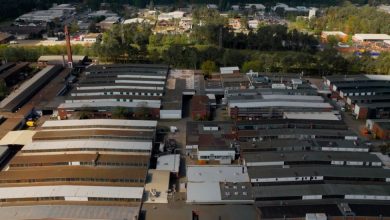Colleges Snap Up Unused Office Space in a Slumping Market

When Jack Welch, the longtime chief executive of General Electric, opened a global headquarters on a sylvan expanse in Fairfield, Conn., in 1974, he probably did not envision college students streaming into its two pristine office buildings. But on a recent morning, students at Sacred Heart University headed to classrooms on floors once filled with file cabinets and cubicles.
Not that all the students at the Catholic university were aware that their classes were in the former home of a multinational conglomerate or were even familiar with the name General Electric.
“I don’t really know what it means, but it’s pretty cool it was something else,” said Mia Romano, an exercise science major who had grabbed breakfast at a snack bar in a big, bright atrium. The university added it recently to one of the buildings as part of its $67 million acquisition and conversion of the 66-acre site into its new West Campus.
At some colleges and universities these days, back to school means back to office buildings.
Dozens of institutions of higher education across the United States have bought office buildings since 2018, including 49 four-year private schools and 16 four-year public institutions, according to data from JLL, a real estate services company. Some of the country’s best-known schools have made purchases this year, including the University of California, Los Angeles, which bought an Art Deco landmark in downtown Los Angeles.
For schools seeking to expand, or just beef up their real estate portfolios, the purchases can be a bonanza: With the office market in a slump, they have bought buildings at bargain prices. Renovations are usually needed, but a makeover is typically not as expensive or as time-consuming as building from scratch.
“It’s a different use but doesn’t need special changes to the building,” said Dror Poleg, an economic historian and author of “Rethinking Real Estate” and the forthcoming “After Office.”
Still, repurposing the buildings for academic use isn’t going to solve the country’s empty-office problem, set off by the pandemic shift to remote work. “It stands out because almost nothing else is happening on the office market,” Mr. Poleg added.
Three years after the start of the coronavirus pandemic, the nationwide office availability rate is more than 24 percent, according to data from the real estate services company Savills, a jump from 17 percent before the pandemic as property owners struggle with many companies’ reduced demand for leased square footage. The value of some office buildings has dropped so much that some landlords are simply letting banks that hold the mortgages take them over.
Government officials and real estate professionals are eager to convert office buildings to homes, given the national housing shortage. But those conversions require overcoming a host of regulatory and architectural challenges, from rezoning for residential use to installing what could be dozens or even hundreds of kitchens and bathrooms, not to mention ensuring that apartments have windows.
Schools aren’t going after just office buildings. As more students elect to live on campus and colleges run out of dorm space, some have resorted to acquiring hotels. But low prices for office buildings have enticed many institutions, even if they don’t have an immediate need for the real estate.
George Washington University exercised an option to buy a 10-story office building from an arm of the World Bank last year, paying a mere $11.5 million for a property valued at $230 million. The building, adjacent to the campus in Washington, houses the Washington Passport Agency on a lease that runs through 2028. A university spokeswoman said the school had not identified a long-term use for the site.
But the University of Southern California bought another office building in Washington to use immediately as a satellite campus, bolstering its presence in the capital, where students do internships in federal offices.
U.S.C. had been leasing space in Washington for years, but with cash in hand and market conditions in its favor, it paid about $49 million for a building in Dupont Circle that had been built in the 1960s for the National Association of Broadcasters. The seller, Stream Realty Partners, had bought the building for more than $31 million in 2018 and then spent about $20 million on upgrades.
“The idea of creating a campus structure in D.C. came up pretty recently,” said the U.S.C. president, Carol L. Folt. “It really came to fruition quickly.”
One college got an office building for free: The University of Louisville was given a building in Louisville, Ky., by Humana, a health insurance company that found it no longer needed the space with so many of its employees working remotely.
There can be a downside for towns and cities when colleges or universities acquire office buildings: They typically don’t pay taxes on their academic buildings and dorms, so the transactions may take properties off the tax rolls.
But lately some elected officials have encouraged the sales in the hopes of enlivening downtowns that have gone quiet as workers have stayed away. The schools can bring employment, prestige and foot traffic that can benefit restaurants and stores.
Not all office buildings can be easily adapted for academic use. If a school is looking to add lab space, office ceilings may not be high enough to accommodate the ductwork needed for enhanced ventilation. And if an office building has large floors, it may be difficult to ensure every classroom has natural light.
Neither challenge was a factor in Sacred Heart University’s transformation of the G.E. headquarters.
Erected when large companies were fleeing cities and building campuses in the suburbs, the headquarters had been a world unto itself, with a medical center, a credit union, a barbershop, dining facilities, a fitness center and a hair salon. The three-story office buildings sat atop parking garages and had central courtyards bringing natural light to interiors. Workers would drive to the property and into the garages and then take elevators to floors outfitted with wall-to-wall cubicles.
“It was a fortress,” said John J. Petillo, Sacred Heart’s president.
But when G.E. put its property on the market and moved to Boston, Sacred Heart — a quarter-mile away and on a growth tear — jumped at the chance to expand, spending $31.5 million in 2016 to buy a property that had been valued at more than twice that, Mr. Petillo said. (The university had long had cordial relations with the company and had named its business school after Mr. Welch.)
To make the buildings more welcoming, the S/L/A/M Collaborative, an architecture firm, replaced the medical center with the atrium — glass walls, double height — as a lounge for students.
“You want to create spaces that are a mixing pot,” said Kevin Herrick, a managing principal at S/L/A/M.
His firm spruced up some spaces: An auditorium got new carpeting and seating with fold-down writing surfaces. A student lounge was added next to what had been the company cafeteria.
Elsewhere, S/L/A/M created a maker space, a finance lab, dance studios, classrooms and faculty offices. Other divisions of the university moved to the new campus, including the business school, which has a wall tribute to Mr. Welch in its lobby.
The renovation cost about $200 per square foot, less than half the cost to build from scratch, Mr. Herrick said. And there are environmental benefits to using existing structures.
Still to be overhauled is G.E.’s former executive suite — a rarefied realm for Mr. Welch and his top deputies, with inlaid floors and walls enlivened with panels of stone or anigre wood.
Sacred Heart plans to turn the floor into a conference center. But the university’s board is already holding meetings in the old G.E. boardroom, which is an improvement over where it used to meet — “on the top floor of the basketball building,” Mr. Petillo said.




